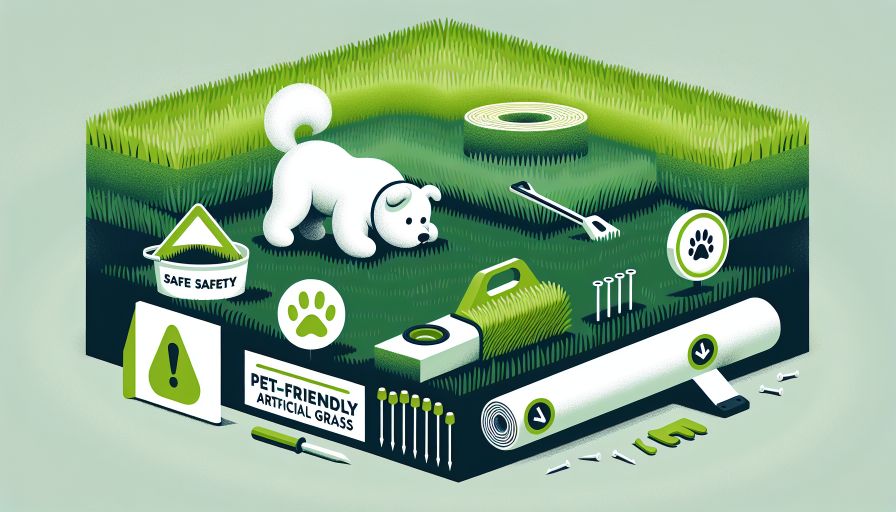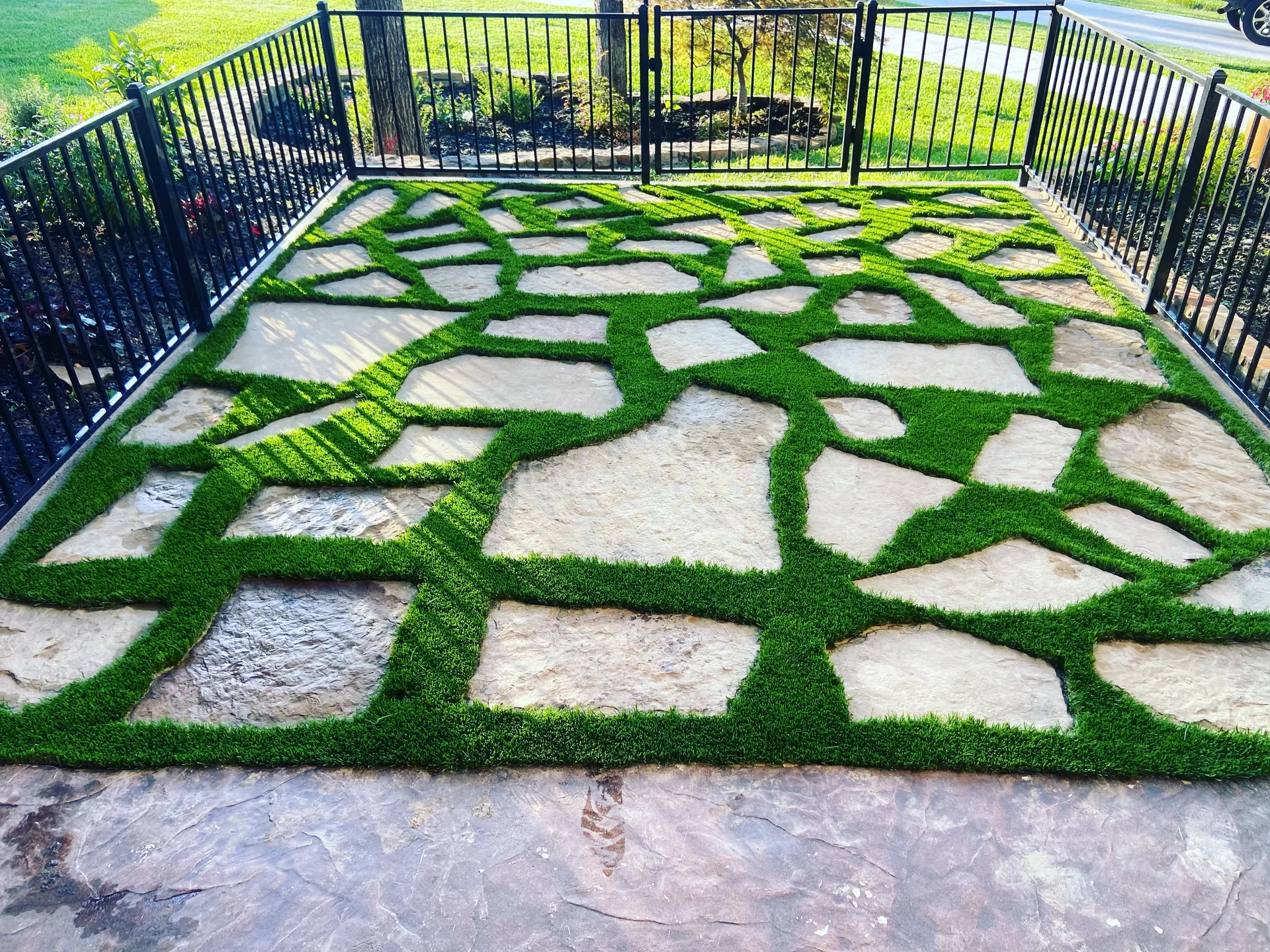
Understanding Pet-Friendly Artificial Grass
When it comes to choosing artificial grass for your backyard, particularly for pet-friendly environments, understanding the fundamentals is crucial. The right artificial grass can significantly enhance the play and relaxation space for your pets, ensuring safety, comfort, and cleanliness.
Artificial grass designed with pets in mind should offer several key features to accommodate their needs. These considerations help ensure a safe and enjoyable space for both pets and their owners.
Durability
One of the primary considerations is the durability of the artificial grass. Pets, especially dogs, can be tough on natural grass, leading to worn-out patches and unsightly messes. Pet-friendly artificial grass must withstand heavy foot traffic, digging, and the repetitive wear and tear caused by active animals.
Prime Design Turf specializes in providing synthetic turf that excels in durability and longevity. With over 20 years of experience, their products are designed to maintain their integrity and appearance despite vigorous pet activities.
Non-Toxic Materials
Safety is paramount, which is why the artificial grass you choose should be made of non-toxic materials. This ensures that your pets are not exposed to harmful chemicals, whether through direct contact or potential ingestion.
Prime Design Turf places a high priority on the safety of your pets by using toxic-free materials. This commitment to health and safety helps provide peace of mind for pet owners who want the best for their furry friends.
Effective Drainage
Good drainage is essential for pet-friendly artificial grass. It aids in maintaining a clean environment by effectively dealing with pet waste and excess water. Proper drainage prevents the buildup of bacteria and odors, contributing to a healthier outdoor space.
The artificial grass solutions from Prime Design Turf incorporate advanced drainage systems to ensure that waste and water are efficiently cleared away, keeping the turf hygienic and dry.
Comfort
Comfort is another significant factor. The grass should feel soft under your pet’s paws and provide a comfortable surface for them to rest and play on. The texture and cushioning of the turf play a large role in this aspect.
With Prime Design Turf, you can expect premium-quality grass that offers a natural feel and softness, ensuring that your pets can enjoy their playtime without discomfort.
Easy Maintenance
Lastly, ease of maintenance is crucial for pet owners. Artificial grass should be simple to clean and maintain, requiring minimal effort to keep it in pristine condition. This not only saves time but also ensures a healthy environment for your pets.
Prime Design Turf provides solutions that are specifically designed for ease of maintenance, combining practicality with high performance. Their products are structured to make cleaning as straightforward and efficient as possible.
- Durability to withstand heavy pet activity
- Non-toxic materials for pet safety
- High-efficiency drainage systems
- Comfortable texture for pets
- Easy maintenance
Understanding these essential aspects when selecting pet-friendly artificial grass ensures that you create a safe, comfortable, and enjoyable environment for your pets.
Health Benefits and Safety Measures
When choosing pet-friendly artificial grass for your backyard, it is vital to consider the health benefits and safety measures for both your pets and household. Ensuring that the artificial turf is safe and non-toxic should be a priority to prevent any potential health risks.
Non-Toxic Materials
One of the most critical aspects of selecting artificial grass is ensuring that it is made from non-toxic materials. Quality manufacturers often provide certifications, such as SGS or ISO standards, to verify their products are free from harmful chemicals like lead and other heavy metals. This assures that the grass is safe for pets to play on and even chew.
Allergen-Free Environment
Artificial grass can help create an allergen-free environment. Natural grass can harbor pollen, mold, and mildew, which can trigger allergies in pets and humans alike. Artificial turf significantly reduces these allergens, providing a safer and more comfortable space for your pets.
Microbial Protection
Some artificial grass products feature built-in antimicrobial properties to help combat bacteria, fungi, and other pathogens. This is particularly important in areas where pets frequently urinate, reducing the risk of infections and ensuring a cleaner play area. Products with antimicrobial protection can mitigate odors and keep the surface hygienic.
Heat Resistance
On hot days, the surface temperature of artificial grass can rise significantly. To protect your pets from potential burns or discomfort, consider grass that includes heat-resistance technology. Materials such as Cool Yarn or HeatBlock Technology are designed to reflect sunlight and reduce surface temperature, ensuring a safer environment for pets.
Proper Drainage
Effective drainage is another key factor when selecting artificial grass. Well-designed turf features built-in drainage systems that prevent water pooling, which can otherwise lead to slippery surfaces and mold growth. Look for products with permeable backing that allows urine and other liquids to pass through easily, maintaining a dry and secure area for your pets.
Cushioning and Joint Protection
Artificial grass with adequate cushioning can provide a softer surface that absorbs impact, protecting your pet’s joints, especially important for older animals. Products with an integrated foam pad or shock-absorbent layers can reduce the strain on pets’ legs and hips during playtime.
- Choose non-toxic, lead-free materials.
- Ensure your turf has antimicrobial properties.
- Consider heat-resistant options for temperature control.
- Opt for proper drainage systems to prevent water buildup.
- Look for additional cushioning to protect pet joints.
Material Selection and Quality Standards
Choosing the right pet-friendly artificial grass involves a detailed understanding of the materials used and the quality standards essential for both pet comfort and backyard safety. This chapter will explore various types of materials available, their benefits, and the quality benchmarks that they must meet to ensure a healthy environment for pets.
Types of Materials
Artificial grass is primarily made from three types of materials: polyethylene, polypropylene, and nylon. Each has its own set of advantages and disadvantages when it comes to pet-friendly applications:
- Polyethylene: Known for its soft texture and realistic appearance, polyethylene is highly durable and resilient. It is also non-abrasive, making it gentle on pets’ paws.
- Polypropylene: The least expensive option, polypropylene is less durable and less soft than polyethylene or nylon. However, it is an option worth considering for short-term use.
- Nylon: Incredibly durable and able to withstand heavy traffic, nylon is resistant to high temperatures. However, it is generally more expensive and may not be as soft as polyethylene.
Quality Standards
Ensuring high quality is crucial for the safety and comfort of pets. Here are some key quality standards to look for:
- Pile Height: The length of the grass blades should ideally be between 1.25 to 1.75 inches for a natural appearance and ease of cleaning.
- Face Weight: This measures the density of the turf. A higher face weight indicates more yarn and, consequently, greater durability. For pet-friendly turf, a face weight of 50 to 70 ounces per square yard is recommended.
- Backing Material: Polyurethane or latex backing ensures durability and ease of installation. Perforated backing is essential for proper drainage, reducing the buildup of waste and odors.
- Infill: Silica sand or anti-microbial infill options help in maintaining cleanliness and reducing odors caused by pet waste. Avoid rubber infill as it may retain heat.
Comparison of Material Properties
The following table gives a quick comparison of the three primary materials used in artificial grass:
| Material | Key Properties |
|---|---|
| Polyethylene | Soft, Durable, Realistic Appearance, Non-abrasive |
| Polypropylene | Inexpensive, Less Durable, Less Soft |
| Nylon | Highly Durable, Heat Resistant, More Expensive |
Additional Considerations
It is also important to look for artificial grass that is UV stabilized to prevent fading and degradation over time. Additionally, opting for grass with a high amount of anti-microbial protection can help in maintaining a cleaner and safer environment for your pets.
By carefully considering these materials and quality standards, you can ensure that the artificial grass you choose will be a safe, durable, and comfortable option for your pets, providing a hassle-free solution for your backyard.
Installation Best Practices for Pet Safety
Ensuring the safe and correct installation of pet-friendly artificial grass is crucial for both the longevity of the product and the well-being of pets. Proper installation can prevent common issues such as uneven surfaces, unpleasant odors, and potential safety hazards. Here are the best practices to follow for safe and secure installation:
Preparing the Ground
Ground preparation is a fundamental step in the installation process. Here are the recommended steps:
- Clear the area: Remove any existing grass, rocks, roots, and debris to create a smooth surface.
- Level the ground: Ensure the ground is even to avoid any tripping hazards and to facilitate proper drainage.
- Apply a weed barrier: Lay down a geotextile fabric to prevent weed growth through the artificial grass.
Drainage Considerations
Proper drainage is essential to avoid water accumulation and associated issues. Effective drainage systems protect against puddles and pet urine buildup.
- Base Layer: Install a base layer of crushed rocks or gravel to enhance drainage. Ensure this layer is compacted and smooth.
- Perforation: Choose artificial grass that has built-in perforations for effective urine and water drainage.
Installing the Artificial Grass
The installation process itself needs to be approached with precision:
- Roll out the grass: Unroll the artificial turf over the prepared base and let it acclimate to the environment for a few hours.
- Trimming: Use a sharp utility knife to trim the edges of the grass to fit the area perfectly.
- Seaming: If multiple rolls are needed, use seam tape and adhesive to create a uniform look without visible joints.
Securing the Turf
Properly securing the artificial grass ensures it remains in place and avoids any lifting or shifting.
- Staking: Use landscape staples or sod pins to secure the edges and seams at regular intervals.
- Weight Distribution: Add infill materials like sand or crumb rubber to weigh down the grass, ensuring stability and a natural feel underfoot.
Pet Safety Considerations
Addressing specific safety concerns for pets during and after installation is essential:
- Avoid sharp objects: Ensure there are no exposed sharp edges or tools left on the installation site that could harm pets.
- Inspect for stability: Regularly check that all edges and seams are securely fixed to prevent pets from chewing or pulling up the material.
- Safe infill materials: Use non-toxic infill materials to ensure they are safe if accidentally ingested by pets.
By following these detailed installation practices, homeowners can create a safe, durable, and pet-friendly outdoor environment that will stand the test of time.
Maintenance and Durability
Maintaining pet-friendly artificial grass requires regular upkeep to ensure durability, hygiene, and safety for both pets and humans. Unlike natural grass, artificial turf doesn’t have the same self-repairing abilities, making maintenance practices even more crucial.
One essential aspect of maintenance is regular cleaning. Pet waste, debris, and dirt can accumulate on the surface, potentially leading to odors and unsanitary conditions. Cleaning the grass involves a few specific steps:
- Solid Waste: Remove solid waste by picking it up with a scooper or disposable bag. It’s vital to prevent the waste from being ingrained into the fibers.
- Liquid Waste: Rinse the affected area with a hose to dilute and wash away urine. This can help prevent unpleasant odors and bacterial growth.
- Deodorizing: Use pet-safe enzymatic cleaners designed explicitly for artificial grass to neutralize odors caused by pet urine.
Another critical factor in maintaining artificial grass’s durability is to brush the turf regularly. This helps to keep the blades upright and prevent matting, which can occur due to high foot traffic from pets and humans. A stiff-bristled brush is recommended for this task.
Artificial grass typically has an infill material, such as sand or rubber, which aids in maintaining the turf’s structure and softness. Over time, this infill can become compacted or displaced. It’s important to periodically check and redistribute the infill, ensuring even coverage across the grass surface.
Proper drainage is fundamental to the longevity of artificial grass. Regular inspections should be conducted to ensure that the drainage system is functioning correctly and that there aren’t any blockages that could lead to water pooling. Standing water can damage the turf and create an environment conducive to mold and mildew growth.
In terms of durability, selecting high-quality artificial grass with UV-resistant properties can significantly extend the lifespan of the product. UV resistance helps prevent the fibers from degrading and losing color due to prolonged sun exposure. Furthermore, opting for products with a strong backing material improves the overall tensile strength, making the turf more resilient to the wear and tear caused by active pets.
Finally, it’s essential to follow the manufacturer’s guidelines for recommended maintenance routines. These guidelines can provide specific recommendations and best practices tailored to the particular type of artificial grass installed in your backyard. Adhering to these instructions can maximize the lifespan and performance of the turf, ensuring a safe and enjoyable outdoor space for your pets.
Environmental Impact and Sustainability
When considering the installation of artificial grass in a pet-friendly backyard, it is crucial to examine the environmental impact and sustainability of the product. Artificial grass varies significantly in terms of eco-friendliness and long-term impact on the environment. By selecting and installing sustainable options, homeowners can reduce their ecological footprint while providing a safe and functional space for their pets.
One of the primary environmental concerns with artificial grass is the materials used in its production. High-quality artificial turf is often made from polyethylene, polypropylene, or nylon. These materials are synthetic polymers, which do not biodegrade easily. However, there are options made from recycled materials that can significantly lessen the environmental burden. Additionally, some companies are now producing artificial grass that includes recyclable components, contributing to a circular economy.
The manufacturing process also plays a critical role in the environmental impact of artificial grass. Energy-intensive processes can lead to substantial carbon emissions. Opting for products manufactured using green energy sources or those that adhere to environmentally-friendly manufacturing practices can further mitigate the negative impact.
Another essential factor to consider is water conservation. Unlike natural grass, artificial turf does not need regular watering, which can result in significant water savings. This is particularly relevant in regions facing drought or water scarcity. However, it’s important to periodically rinse artificial turf to remove dirt and pet waste, which does use some water—but still far less than natural grass.
Infills are used in artificial grass systems to provide cushioning and support. Traditional options such as rubber crumb or sand might not be the most sustainable. Many manufacturers now offer alternative infills made from natural cork or coconut fibers, which are biodegradable and pose fewer environmental risks.
End-of-life disposal of artificial grass is another critical consideration for sustainability. While the lifespan of quality artificial grass can range from 10 to 20 years, planning for its disposal is essential. Some innovative solutions include artificial grass products that are 100% recyclable or can be returned to the manufacturer for recycling. It’s also worth exploring local recycling programs that accept synthetic turf.
Beyond material selection, the actual installation process itself should minimize harm to the environment. When installed correctly, artificial grass can prevent soil erosion and reduce the need for pesticides and fertilizers, which are common pollutants in traditional landscaping.
In summary, selecting pet-friendly artificial grass with a strong emphasis on environmental impact and sustainability involves careful consideration of materials, manufacturing processes, water conservation, infill choices, and end-of-life disposal. By prioritizing these factors, homeowners can create an eco-friendly, safe, and enjoyable outdoor space for their pets.
Cost Analysis and Long-Term Value
When considering the installation of pet-friendly artificial grass, it is crucial to conduct a comprehensive cost analysis to understand both the immediate and long-term financial implications. Initial costs, maintenance expenses, and the long-term value are all critical factors to evaluate.
The initial cost of artificial grass varies significantly depending on the quality of the material, the size of the area, and the complexity of the installation. Typically, higher-quality materials designed specifically for pet use are more expensive due to their enhanced durability and safety features. On average, the cost can range from $5 to $20 per square foot for materials and installation.
Maintenance costs should also be considered when evaluating the long-term value of artificial grass. Unlike natural grass, which requires regular watering, fertilizing, and mowing, artificial turf requires minimal maintenance. However, it is essential to clean and sanitize the turf to prevent odors and remove pet waste effectively.
- Cleaning solutions: Specialized pet-safe cleaning solutions are necessary and may add to your maintenance costs.
- Durability: High-quality artificial grass can last 15-20 years, offering substantial long-term savings compared to natural grass, which may require frequent reseeding and pest control.
- Repairs: While artificial grass is generally durable, occasional repairs may be necessary. These costs should be factored into your long-term budget.
Here is a comparative table for an overview of potential costs:
| Expense Type | Estimated Cost Range |
|---|---|
| Material and Installation | $5 – $20 per sq. ft. |
| Annual Maintenance | $100 – $300 |
| Cleaning Solutions | $50 – $150 per year |
| Potential Repairs | Varies (dependent on extent of damage) |
Overall, investing in pet-friendly artificial grass can yield long-term value by reducing ongoing maintenance and repair costs while providing a safe and durable play area for pets. To ensure the most cost-effective decision, examine all related expenses and weigh them against the benefits of lower maintenance and increased durability.



